
The Wii is a home video game console developed and marketed by Nintendo. It was released on November 19, 2006, in North America and in December 2006 for most other regions of the world. It is Nintendo's fifth major home game console, following the GameCube and is a seventh-generation console alongside Microsoft's Xbox 360 and Sony's PlayStation 3.
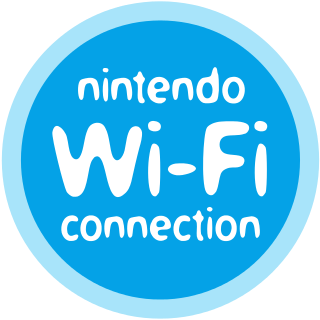
Nintendo Wi-Fi Connection (WFC) is an online multiplayer gaming service run by Nintendo to provide free online play in compatible Nintendo DS and Wii games. The service included the company's Wii Shop Channel and DSi Shop game download services. It also ran features for the Wii and Nintendo DS systems.
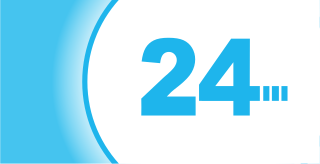
WiiConnect24 was a feature of the Nintendo Wi-Fi Connection for the Wii console. It was first announced at Electronic Entertainment Expo (E3) in mid-2006 by Nintendo. It enabled the user to remain connected to the Internet while the console was on standby. For example, a friend could send messages to another player's town without the other player being present in the game in Animal Crossing: City Folk.
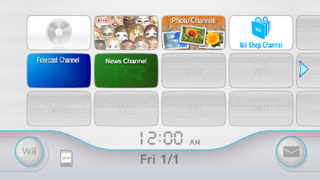
The Wii Menu is the graphical shell of the Wii and Wii U game console, as part of the Wii system software. It has four pages, each with a 4:3 grid, and each displaying the current time and date. Available applications, known as "channels", are displayed and can be navigated using the pointer capability of the Wii Remote. The grid is customizable; users can move channels among the menu's 48 customizable slots. By pressing the plus and minus buttons on the Wii Remote users can scroll across accessing empty slots.

The Wii Shop Channel is a discontinued digital distribution service for the Wii video game console. The service allowed users to purchase and play additional software for the Wii, including exclusive games, and games from prior generations of video games. The Wii Shop Channel launched on November 19, 2006, and ceased service operations worldwide on January 30, 2019. Users can still re-download previously purchased software and/or transfer Wii data over from a Wii to a Wii U, however Nintendo claims that these features are going to eventually be discontinued at some point.
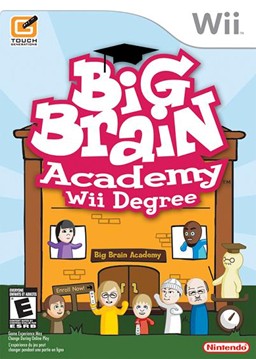
Big Brain Academy: Wii Degree, known in PAL regions as Big Brain Academy for Wii, is a video game released for the Wii. A sequel to the game Big Brain Academy for the Nintendo DS, it too measures a player's brain's weight, but with new games and puzzles to solve. The game makes use of Miis and uses WiiConnect24 features, allowing competition amongst users' friends, whose codes are automatically imported from the Wii's internal address book.

A Mii is a customizable avatar used on several Nintendo video game consoles and mobile apps. The name Mii is a portmanteau of “Wii” and “me”, referring to them typically being avatars of the players. Miis were first introduced on the Wii console in 2006 and later appeared on the DS, 3DS, the Wii U, the Switch, and various apps for smart devices such as Miitomo. Miis can be created using different body, facial and clothing features, and can then be used as characters within games on the consoles, either as an avatar of a specific player or in some games portrayed as characters with their own personalities. Miis can be shared and transferred between consoles, either manually or automatically with other users over the internet and local wireless communications.

The Wii system software is a discontinued set of updatable firmware versions and a software frontend on the Wii home video game console. Updates, which could be downloaded over the Internet or read from a game disc, allowed Nintendo to add additional features and software, as well as to patch security vulnerabilities used by users to load homebrew software. When a new update became available, Nintendo sent a message to the Wii Message Board of Internet-connected systems notifying them of the available update.

The Check Mii Out Channel, known as the Mii Contest Channel in Europe, Oceania and Japan, was a channel for the Nintendo Wii that allowed players to share their digital avatars, called Miis, and enter them into popularity contests.

We Ski is a 2008 skiing video game for the Wii developed and published by Namco Bandai Games. It is the first third-party game released that makes use of the Wii Balance Board.

Wii no Ma was a Wii channel that featured a video-on-demand, film rental and shopping service operated by Nintendo and Dentsu. Wii no Ma was released on 1 May 2009, exclusively in Japan, and it could be downloaded from the Wii Shop Channel for free, although paid videos could be purchased with Wii Points. The service was shut down on 30 April 2012.

Wii Party is a party video game developed and published by Nintendo for the Wii video game console. The game heavily borrows game play elements from the Mario Party series, another Nintendo franchise. It is also the first game in the Wii series that Shigeru Miyamoto did not produce. The game was released in Japan on July 8, 2010, in North America on October 3, 2010, in Australia on October 7, 2010, and in Europe on October 8, 2010. Wii Party was revealed by Satoru Iwata in a Financial Results Briefing on May 7, 2010. It received mixed to positive reviews from critics and sold 9.35 million copies worldwide as of September 2021. A sequel, Wii Party U, was released for the Wii U on October 25, 2013.
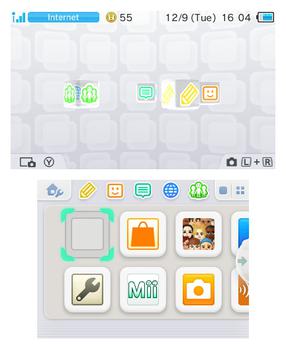
The Nintendo 3DS system software is the updatable operating system used by the Nintendo 3DS handheld system. The Nintendo Switch system software is believed to have evolved from the Nintendo 3DS system software.
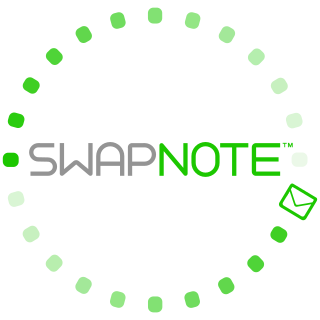
Swapnote, known as Nintendo Letter Box in PAL regions and Suddenly Exchange Diary in Japan, was a messaging application for the Nintendo 3DS family. Swapnote was released worldwide in December 2011 via the Nintendo eShop. It could have been downloaded at no additional cost and was pre-installed on newer systems. Swapnote was the successor to the PictoChat app for the Nintendo DS line.
The Nintendo Network is Nintendo's online service which provides online functionality for the Nintendo 3DS and Wii U systems and their compatible games. Announced on January 26, 2012, at an investors' conference, it is Nintendo's second online service after Nintendo Wi-Fi Connection. Former president of Nintendo Satoru Iwata said, "Unlike Nintendo Wi-Fi Connection, which has been focused upon specific functionalities and concepts, we are aiming to establish a platform where various services available through the network for our consumers shall be connected via Nintendo Network service so that the company can make comprehensive proposals to consumers."

Miiverse was a social network for Nintendo 3DS and Wii U, created by Nintendo System Development and Hatena, and powered by the Nintendo Network. Integrated into many games, Miiverse allowed players to interact and share their experiences by way of handwritten messages or drawings, text, screenshots, and sometimes game videos in dedicated communities. It was available via any web browser, and a dedicated app version originally planned for tablets and smartphones. All users who signed up for a Nintendo Network ID were automatically given a Miiverse profile per account, represented by the Mii avatar connected to said Nintendo Network ID.

The Wii U system software is the official firmware version and operating system for Nintendo's Wii U home video game console. Nintendo maintains the Wii U's systemwide features and applications by offering system software updates via the Internet. Updates are optional to each console owner, but may be required in order to retain interoperability with Nintendo's online services. Each update is cumulative, including all changes from previous updates.
SpotPass and StreetPass are communication systems first introduced in the Nintendo 3DS. SpotPass was later incorporated into the Nintendo 2DS, models of the New 3DS and New 2DS, and Wii U game consoles. SpotPass delivers content from the Internet to the consoles, and StreetPass uses local Wi-Fi functionality to exchange data between 3DS, 2DS, and Wii U systems.

TV no Tomo Channel: G-Guide for Wii was a Wii channel that featured an electronic program guide service developed by Nintendo and HAL Laboratory and operated by G-Guide.
Demae Channel was a Wii channel that featured a food delivery service developed by Nintendo and Denyusha and operated by Demaecan. It was launched on 26 May 2009, exclusively in Japan, and it was available as a free download on the Wii Shop Channel. In addition, a Wii U version was released on 8 August 2013.


















